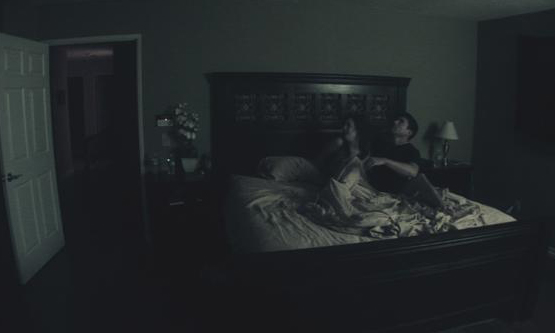Paranormal Activity's Domestic Demons
There’s a neat little horror film that is slowly unrolling across North American theatres which, thanks to online buzz such as this, is angling for a spot as the most phenomenal piece of indie genre cinema since The Blair Witch Project. Like Blair Witch, The Last Broadcast and bigger budgeted flicks like Cloverfield and Quarantine, Oren Peli’s Paranormal Activity is another entry in the faux-doc, shaky cam school of horror cinema aesthetics. But what’s most interesting about this film is not merely its ability to capitalize on a culture acclimatized to the voyeurism of YouTube, or its function as a case study of how a humble film with a $15,000 budget can fall into the hands of Steven Spielberg and end up seeing a two thousandfold return on its investment. What’s most interesting, for me at least, is its careful study of male/female relationships.
Like the oft-maligned Antichrist—which I’ve been coming around to more and more, and am excited to see again—Peli’s film develops its male and female protagonists along axes so conservative it’s laughable. Like Trier’s film, Paranormal Activity proceeds from the ol’ Cartesian split suggesting that men are the cold, clinical emissaries of an ineffable rationalism and women are the impassioned ambassadors of an embodied physicality. This is a trope as typical to horror cinema as the “Final Girl” or variations on screechy audio cues lifted from Psycho’s famous shower scene.
It goes at least as far back as the differently configured hysterics of Linda Blair and Ellen Burstyn in The Exorcist, or Mia Farrow’s rearranging of Scrabble tiles to suggest to her callous husband that their neighbours are Satanists in Rosemary’s Baby. But where little Regan must have her devils expelled by some impotent priests, and Roe must come to accept her Satan-spawned demonseed, Paranormal Activity is suggestive of a feminine dynamic that is not subject to the wills of incapable men or the expectations of motherhood.
Paranormal Activity follows Katie and Micah, a young couple who have been the victim of some unexplained (or paranormal) phenomena (or activity) shortly after moving in together. Katie believes that she is being tormented by a ghost or demon that has tailed her since she was eight years old. Micah, the sceptic and sober second-thought, buys a high-grade digital camera to record goings-on around their house in order to find proof. (The film itself, like Blair Witch and similarly styled films, is composed entirely of this “found” footage.)
The standard male/female split is established early in the film. Micah’s cynicism and constant toying with his camera greatly annoys his girlfriend, who believes that his arrogance and goading will only further agitate this malevolent spirit. He works as a day trader, is clearly comfortably wealthy, and doesn’t trust psychic intervention. She is an English student who pretends to support herself by making tacky bracelets and doesn’t trust Micah tampering with a Ouija board. Their fundamental difference in approach strains their relationship over the course of the film, which further nourishes their unwelcome houseguest who feeds on this sort of negative energy. That most of the unexplainable weirdness goes down in the vicinity of the couple's shared bed further enlivens the film's grappling with these more domestic demons.

If you’re at all into the extrascientific—demonology, ghosts, ghouls and all that—Micah and Katie’s rapport may seem cannily familiar. I’ve seen countless episodes of A&E ghost hunting and paranormal investigative programs where a wife will firmly believe to feel the presence of some poltergeist while the husband will firmly rebuff such claims. Likewise, Micah’s the kind of guy who would rather “fix” the problem than be attentive to the very real needs of his partner; preferring to strive for some empirical high-ground instead of providing the comfort that adults in mature relationships should offer one another. It’s a more salient echo of the relationship between Justin Long and Alison Lohman in Sam Raimi’s recent (and excellent) Drag Me to Hell.
I’m hesitant to say much more about Paranormal Activity, mainly because it’s a deliberately-paced (read: slow) spooker that relies on variously compelling plot twists and revelations. But suffice it to say, I found it be a wonderfully engaging no-budget film that, by the time it wraps, has contributed substantially to the discourse of male/female relationships that often provide the thematic undercurrent to domestic horror films. I also found it genuinely terrifying in moments.
My girlfriend, on the other hand, was decidedly underwhelmed.





